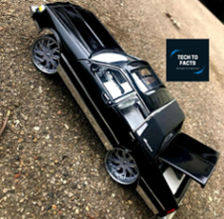The world of remote-controlled (RC) car enthusiasts presents an exciting avenue for those captivated by the mesmerizing art of drifting. Comparable to the precision of professional drivers, mastering techniques for RC drift involves a delicate interplay of skill, finesse, and technique. This article looks into the intricate tapestry of mastering techniques for RC drift cars, unraveling the multifaceted elements that culminate in achieving controlled slides with the utmost precision.
What is RC Car Drift?
RC car drift encapsulates the captivating art of controlled sliding, deliberately inducing the rear wheels to lose traction while maneuvering corners. The symphony of controlled slides necessitates a synchronized harmony of throttle, steering, and brakes, culminating in graceful drifts reminiscent of professional motorsport drifting. The allure of RC car drift lies in precision and style, with each maneuver executed as an artistic expression.
Tires:
Tires stand as the tangible bridge between the RC car and the surface. The selection of tires plays a pivotal role in orchestrating successful drifts. Opting for slick or low-traction tires fosters seamlessly controlled slides, allowing the rear wheels to lose traction gracefully. The delicate balance of tire compound, width, and tread pattern is pivotal in optimizing the fragile equilibrium between grip and slip, the hallmark of proficient drifting.
The Role of Weight Distribution
Effective weight distribution emerges as a cornerstone for executing controlled drifts. Shifting the car's weight towards the rear end bolsters traction on the front wheels, provoking controlled sliding at the rear. Fine-tuning weight distribution via battery placement or additional weights refines the car's responsiveness during drifts, granting an elevated command level over its movements.
Throttle Control:
The throttle emerges as the conductor's baton in the orchestration of RC car drift. Skillful modulation of the throttle holds the key to initiating and sustaining drifts. The dance of the throttle demands precision, as excessive throttle can lead to uncontrolled spins, while inadequate throttle can straighten the car's trajectory. A harmonious synchronization of throttle manipulation, steering adjustments, and brake finesse crafts a symphony of controlled sliding.
Steering Techniques:
Countersteering is a pivotal technique in RC car drift, involving steering in the opposite direction of the turn to sustain the drift. The execution of countersteer necessitates finesse, as drivers fluidly transition between steering inputs to maintain the desired drift angle. Swift timing is imperative, preventing the pitfalls of over- or under-steering that can destabilize the slide.
Braking:
Though seemingly counterintuitive, braking is critical in mastering RC car drift. Gentle application of brakes shifts weight to the front tires, enabling the car to regain grip and control. Skillful drivers leverage subtle brake inputs to manipulate the drift angle, averting the risk of spinning out. The delicate equilibrium achieved through the interplay of throttle, steering, and brakes facilitates precise control during each drift maneuver.
Practice Makes Perfect:
Mastery of RC car drift is an art that evolves through persistent practice and unwavering patience. Regular practice sessions pave the path for drivers to fine-tune their techniques, develop muscle memory, and decode the nuances of their specific RC car's behavior. Iteratively experimenting with tire configurations, weight distribution, and steering methodologies refines skills, sharpening the ability to command the car's slide with finesse.
Advanced Techniques:
Once the bedrock of fundamentals is firmly established, RC enthusiasts can delve into advanced drifting techniques to elevate their mastery. Drift entries, clutch kicks, and feint maneuvers are advanced techniques that adept drivers deploy to execute intricate and visually captivating drifts. With growing confidence and experience, drivers experiment with these techniques, adding complexity and innovation to their drifting repertoire.
Conclusion:
Mastering techniques unveils a journey marked by precision and artistry in the exhilarating universe of RC drift cars. The artfully controlled slides, akin to their professional counterparts, culminate from the meticulous orchestration of tire choices, weight distribution, throttle manipulation, steering dexterity, and the finesse of brake modulation.
Analogous to a conductor harmonizing an orchestra to craft a harmonious symphony, adept RC car drivers orchestrate the intricate choreography of components, resulting in seamless and controlled drifts. The delight of executing these maneuvers with style and precision is a testament to the unwavering dedication and boundless passion of RC car enthusiasts who embrace the art of mastering techniques for RC drift.



